

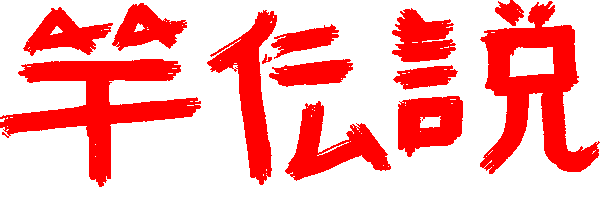


[Watch FILM] [Poster] [Script] [Stills / Gifs ]
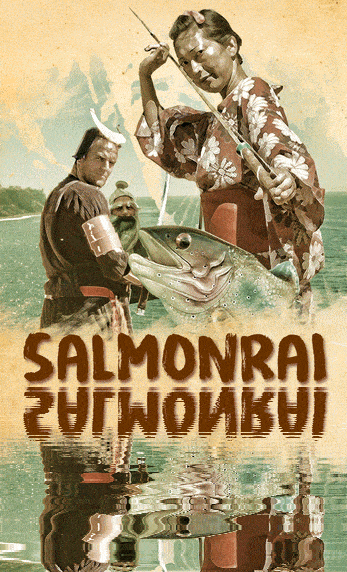
CHARACTER & ACTOR PROFILES
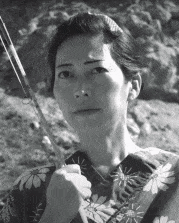
Sari played by Erika Maki
Her life turns upside down when a magical fishing rod appears before her. Will she be able to stop the evil Samurai Sanjuro-Face?
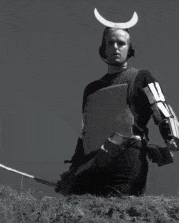
Samurai Sanjuro-Face played by Casey Poma and voiced by Koji Asano
An evil samurai hell-bent on obtaining the magical fishing rod...at any cost.
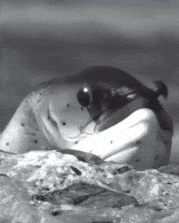
Salmon Master voiced by Erika Maki
This unlikely master warns Sari of the dangers the magical rod can bring.
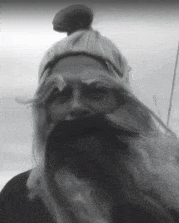
Sensei played by Daniel "Holmes" Lujan
The previous master of the magical rod that Samurai Sanjuro-Face so desperately desires!
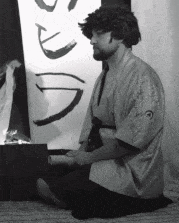
Servant played by Ralph Blanchard and voiced by Koji Asano
Servant to Samurai Sanjuro-Face. He serves the Samurai his meals and bears bad news.
PRODUCTION HISTORY
From 2013-2015, Ralph and Casey had released three Halloween specials: HOnTed DOG, Apple Die, and U.PH.O. What was to be for Halloween 2016? Unsure if they would do a fourth one, they waited a long time to come up with an idea. They were discussing it one day while Casey was watching Sanjuro in his quest to get through all of Akira Kurosawa’s films. While the white flowers were traveling through a small stream (an important image in the film), they had the idea to try a Kurosawa-inspired Samurai film. By this time, it was already late summer, so their Samurai film would be put on the fast-track.
The earliest food-pun title for the film was “Samurice” (perhaps the most obvious food pun available) and told the tale of a legendary sword that could lay down new rice just by running its edge along the ground. This idea was ultimately scrapped (this is also not actually how rice grows). The name was changed to Salmonrai, which seemed like a more groan-inducing pun, and would allow for a story about a talking fish master. Never ones to make things easy on themselves, Ralph and Casey decided the entire film would be either filmed in or dubbed into Japanese.
The script was hastily written, and, near the end of September, was sent to a Japanese translator and voice-over artist through Fiverr. Ideally, Casey and Ralph would have learned the Japanese and performed it on camera, but there was simply no time given the shooting schedule. Translator Koji Asano would perform all the voice over for the main villain and his attendant. (He would also later provide translations for the opening and closing credits, as well as Japanese characters for the poster).
For the main actress, Ralph and Casey knew they would have to a native speaker. To help with this, Ralph contacted a co-worker at the time, Tony Laudati, who was the founder and producer of the YouTube martial-arts webseries Kung Fu Femmes. Tony got them in touch with a few Japanese actresses (he also lent him his swords!). One of them, Erika Maki, was excited about the project and would become the main character Sari. They met with her before production began, discussing the project. She agreed to do it! Ralph and Casey were happy. They had their lead actress.
Salmonrai would not only prove to be more complicated in terms of language and translations, but in locations as well. The film called for a Japanese garden. It was soon after that they discovered filming at Japanese gardens is not cheap. They contacted a few, and were rebuffed by the prices, which could reach $1,500 dollars per day. A brewery in San Diego, where they had attended a wedding just a month or so earlier, had a small Japanese garden off their balcony, featuring a pond and a bridge. It was a great location. Ralph and Casey reached out to the brewery multiple times, but never heard anything back. Ralph reached out to the Japanese garden in San Diego’s Balboa Park. While prices were initially high, he was able to talk them down to a rate of $100 an hour.
This would be the longest shoot-day of the production, traveling extensively through LA and then back and forth from San Diego. In total, the work day would be very long and Ralph’s car would clock in just short of 300 miles round-trip. The location paid off and looks great in the final film, although the filmmakers could not stop other visitors from entering the gardens and being in the background of shots. The entire garden shoot took place in 2 hours, and $200 was paid.
The rest of the film was shot at various locations. The close-ups of Master Salmon in the river were filmed in a hot tub at Carly’s parents’ mobile home park’s hot tub (on October 13). The scenes featuring the evil villain with his subordinate were filmed inside Ralph and Casey’s living room, with all the furniture moved out of the space and crammed into the kitchen.
The most prominent location was the seaside cliff area, which was used for the beginning of the film and the climax. These scenes were filmed at the Bluff Cove Trail in the Malaga Cove section of Palos Verdes Estates, CA. Throughout the production, at least five different trips would be taken to the Trail, with different aspects of the film being covered.
The search for a convincing castle exterior (for establishing shots of the villain’s lair) would prove to be a doozy. Casey initially thought to use stock footage of Japan’s Himeji Castle, but Ralph urged that no stock footage be used. It was decided they would attempt a model. Many castle models and model kits were found online, but all of them would need to be shipped from Asia, and wouldn’t arrive by the premiere of the movie. Casey ventured to Los Angeles’s Little Tokyo in search of a castle model. Despite there being an entire store just for models, Casey was unsuccessful in finding a castle (the store was filled mostly with robots). Luckily, he found a tiny souvenir castle statue. It measured perhaps 1.5 inches tall. Later, small model trees were bought at Michaels and glued to the base of the castle. The large castle in the film is in fact barely larger than a quarter! Movie magic! The model was perched on a rock at the Bluff Cove Trail and filmed on October 21. Rain and lightning were added in post production.
A promotional poster for Salmonrai was released on Facebook October 16, while shooting was still going on. Another promotional teaser was sent three weeks later, featuring a still from the movie, on October 19. The final poster of the film, designed by a user on Fiverr (the first time Casey or Ralph had outsourced this process), was posted October 29.
Ralph and Casey pulled a two near-all nighters (sleeping only a few hours between themselves in shifts) to complete the film in time, and Salmonrai was released on schedule (with some audio problems). A new version, with repaired audio, was uploaded a few days later.
